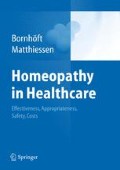Abstract
The characteristic features of homeopathy are its particular drug therapy and application, its drug provings on the healthy subject, the development of its pharmacology, the case-taking and exact observation of the individual patient’s symptoms and idiosyncrasies, the conclusions drawn from numerous individual healing processes and its extended treatment target. All these aspects result in an approach that is fundamentally different, in theory and practice, from mainstream medicine. While both systems are based on exact empirical observation, their methods of observation and interpretation differ. In mainstream medicine, treatment is based on the clinical diagnosis while the symptoms displayed by the individual patient play a lesser role. In homeopathy, on the other hand, the choice of medication depends on the totality of symptoms and signs displayed by the individual patient. The clinical diagnosis is important for assessing the medical situation but has little bearing on the choice of remedy. Administering homeopathic remedies and mixtures merely on the basis of a clinical diagnosis goes against the principles of homeopathy.
Access this chapter
Tax calculation will be finalised at checkout
Purchases are for personal use only
Preview
Unable to display preview. Download preview PDF.
References
Blackie M (1990) Lebendige Homöopathie. Sonntag, Munich
Braun A (1995) Methodik der Homöotherapie. Sonntag, Stuttgart
Genneper T, Wegener A (2001)Lehrbuch der Homöopathie. Haug, Heidelberg
Gumpert M (1989) Hahnemann, 2nd edn. Aurum, Freiburg i. Br.
Gypser KH (1995) Wissenswertes für Patienten über Homöopathie. Haug, Heidelberg
Haehl R (1925) Samuel Hahnemann (biography), 2 vols. Schwabe, Leipzig
Hahnemann S (1983) Die chronischen Krankheiten, theoretischer Teil (1828). Haug, Heidelberg
Hahnemann S(1999) Organon der Heilkunst (1842). Haug, Heidelberg
Halter K, Righetti M (1998) Klassische Homöopathie (parts 1–3). Zum Nachweis von Wirksamkeit und Nutzen einer komplementärmedizinischen Methode. Schweizerische Zeitschrift für Ganzheitsmedizin. 10:252–257, 343–346 und (1999) 11:1
Illing KH (1988) Homöopathie für Anfänger (introduction), Homöopathische Taschenbücher vol 1. Haug, Heidelberg
Kent JT (2002) Repertory of the Homeopathic Materia Medica (6th American edn, reprint). Jain Publishers, Delhi
Köhler G (1993) Lehrbuch der Homöopathie, vol 1. Grundlagen und Anwendung. Hippokrates, Stuttgart
Meili W (1989) Grundkurs in klassischer Homöopathie. Sonntag, Regensburg
Righetti M (1988) Forschung in der Homöopathie; Grundlagen, Problematik und Ergebnisse. Burgdorf, Göttingen
Schroyens F (1993) Synthesis Repertorium. Homeopathic Book Publishers, London
Seiler H (1988) Die Entwicklung von Samuel Hahnemanns ärztlicher Praxis anhand ausgewählter Krankengeschichten. Haug, Heidelberg
Stumpf W (1990) Homöopathie. Gräfe und Unzer, Munich
Van Zandvoort R (1994) The complete repertory. IRHIS-Verlag, Leidschendamm
Vithoulkas G (1986) Die wissenschaftliche Homöopathie. Burgdorf, Göttingen
Voegeli A (1993) Die korrekte homöopathische Behandlung in der täglichen Praxis, 10th edn. Heidelberg: Haug,
Wright-Hubbard E (1993) Kurzlehrgang der Homöopathie, 2nd edn. Barthel & Barthel, Berg
Author information
Authors and Affiliations
Editor information
Editors and Affiliations
Rights and permissions
Copyright information
© 2011 Springer-Verlag Berlin Heidelberg
About this chapter
Cite this chapter
Righetti, M., v. Ammon, K., Mattmann, P., Thurneysen, A. (2011). Introduction to the speciality of homeopathy – principles and definition. In: Bornhöft, G., Matthiessen, P.F. (eds) Homeopathy in Healthcare – Effectiveness, Appropriateness, Safety, Costs. Springer, Berlin, Heidelberg. https://doi.org/10.1007/978-3-642-20638-2_3
Download citation
DOI: https://doi.org/10.1007/978-3-642-20638-2_3
Publisher Name: Springer, Berlin, Heidelberg
Print ISBN: 978-3-642-20637-5
Online ISBN: 978-3-642-20638-2
eBook Packages: MedicineMedicine (R0)

